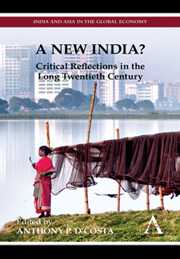Book contents
- Frontmatter
- Contents
- List of Tables and Figures
- Foreword by Deepak Nayyar
- Preface and Acknowledgements
- Chapter 1 What is this ‘New’ India? An Introduction
- Chapter 2 New Interpretations of India's Economic Growth in the Twentieth Century
- Chapter 3 Continuity and Change: Notes on Agriculture in ‘New India’
- Chapter 4 An Uneasy Coexistence: The New and the Old in Indian Industry and Services
- Chapter 5 Is the New India Bypassing Women? Gendered Implications of India's Growth
- Chapter 6 The ‘New’ Non-Residents of India: A Short History of the NRI
- Chapter 7 Revivalism, Modernism and Internationalism: Finding the Old in the New India
- Chapter 8 Creative Tensions: Contemporary Fine Art in the ‘New’ India
- List of Contributors
- Index
Chapter 4 - An Uneasy Coexistence: The New and the Old in Indian Industry and Services
Published online by Cambridge University Press: 05 March 2012
- Frontmatter
- Contents
- List of Tables and Figures
- Foreword by Deepak Nayyar
- Preface and Acknowledgements
- Chapter 1 What is this ‘New’ India? An Introduction
- Chapter 2 New Interpretations of India's Economic Growth in the Twentieth Century
- Chapter 3 Continuity and Change: Notes on Agriculture in ‘New India’
- Chapter 4 An Uneasy Coexistence: The New and the Old in Indian Industry and Services
- Chapter 5 Is the New India Bypassing Women? Gendered Implications of India's Growth
- Chapter 6 The ‘New’ Non-Residents of India: A Short History of the NRI
- Chapter 7 Revivalism, Modernism and Internationalism: Finding the Old in the New India
- Chapter 8 Creative Tensions: Contemporary Fine Art in the ‘New’ India
- List of Contributors
- Index
Summary
Introduction
The society and economy in India present a picture of great contrasts. India is the second fastest growing economy of the world and prides itself on its globally competent firms and professionals. Yet, vast sections of small peasants and rural and urban labourers in India continue to survive under conditions of extreme deprivation. Truly, the old India coexists uneasily with a new, emergent India. The aim of this chapter is to understand such coexistence in two important sectors of the Indian economy: industry and services.
India has a young population, the source of its ‘demographic dividend’. In 2004, the proportion of population below 15 years of age was 32.5 per cent in India, compared to only 22 per cent in China (UNDP 2006, 297–300). India has a large English-speaking population. Approximately 10 million students were enrolled for tertiary education in India in 2000–1. With respect to the numbers of students enrolled for tertiary technical education, India is ahead of the United States (UNCTAD 2005, 162).
However, the other side of the coin is that India has low work participation rates, especially of women, low literacy rates and a relatively high incidence of poverty and undernourishment. In 2005, the urban labour force participation rate was only 53.8 per cent in India compared to 77.2 per cent in China (OECD 2007). The literacy rate among adults above the age of 15 in 2000–4 was only 61 per cent in India compared to 91 per cent in China (World Bank 2007).
- Type
- Chapter
- Information
- A New India?Critical Reflections in the Long Twentieth Century, pp. 71 - 98Publisher: Anthem PressPrint publication year: 2010
- 6
- Cited by



